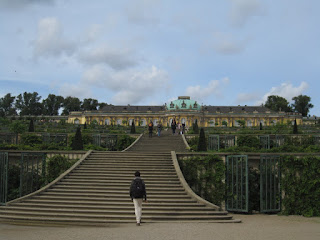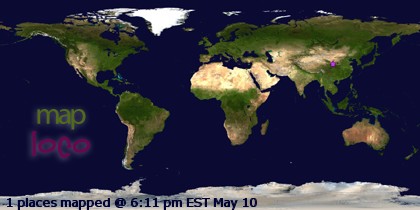I’m no drug user, but it’s hard for me to believe that I could ever find a substance that would give me the kind of high-- sharp, bright bolts of happiness, upwellings of utter contentment, excitement, fascination--that travel has given me. Everything is so colorful, intense, exciting, different, and it leads to moments of uttery joy. I’m thinking about how I felt watching the sun set on the top of the hill next to my guesthouse on Naxos in Greece. Singing drinking songs with Tibetan migrants. Playing with the kids at the Turkish circumcision ceremony. Climbing up to the world’s farthest-east cliff at dawn in New Zealand. Dancing with Aztecs in Mexico on the equinox. I don’t think I will ever find something so soul-filling, so dazzling, so ecstatic.
Longtime readers of this blog may remember that it is this ecstasy that led me here, to Spain. I had so many wonderful experiences, met so many wonderful people in the course of my yearlong nomadic existence, but it was really difficult to always be leaving people and places I had just come to love. What it would be like, I wondered, to put down roots somewhere foreign instead of always moving onward and upward? didn’t know it, but in the first weeks of my life in Palencia, as I started answering that question, I was carrying that ecstasy with me. It was weighing me down.
Before I left Boston, at one of the many jubilant goodbye shindigs I attended, a friend pulled me aside and gave me a pair of earrings and a peptalk. “The first week is going to be wonderful, and I want you to wear these and think about how kickass you are. And the second week is going to suck. You’re going to wonder what you’ve gotten yourself into, where you’ve ended up. You’re going to want to go home. And I want you to wear these, then, too,” she told me.
I heard her, in the sense that the sound vibrations were processed in my eardrum and through my brain… but I don’t think I really heard her.
It sucked, really, at depths I hadn't anticipated. The first few moments in Palencia were of wonder, sure. I took the walk down Calle Mayor described a few entries ago, charmed by the place. It didn't take long for charm to fade into shock, frustration, fear, though. I found the hostel I’d booked for the first few nights, met up with some fellow teaching assistants, started looking for apartments. But although technically I was moving, it felt like standing still. Everything was doubly difficult: I was unable to find internet, let alone an apartment; unable to understand anything or make myself understood. I felt like I was bathing in anxiety, never able to relax or unclench my jaw. Five days in, I had the predicted melt down, wanting to run away somewhere… but to where, exactly?
I didn’t run. Instead, over the course of a week I forced myself to start to get a feel for the town. I found a café, Chaval de Lorenzo, with Wifi, where I made friendly chit-chat with the young Cuban waiter, Guillermo. The cafe staff learned to expect me in the evening for dinner or a cup of kolakao (a Spanish brand of hot cocoa), while old men around me cheered for the Valladolid futbol game or Leon bullfight. I met the teachers (almost all women) at my school’s English department, drinking espresso with them by the banks of the Carrion. I strolled along the Calle Mayor at dusk, enjoying the traditional paseo with what seemed like the whole town. I discovered the cathedral and its circling storks; I climbed the Cristo Otero, the giant Jesus statue outside town. It all sounds awfully romantic, doesn’t it?
I couldn’t understand why it didn’t feel romantic. It didn’t feel like anything. I wasn’t excited or ecstatic; I also wasn’t despondent. Instead, I was confused. I was living a dream, albeit a stale one. I was setting up a life in a new country, where every day brought me the fascinating, the picturesque, the new and different. Where were those bolts of pure happiness? I felt frustrated and numb. I woke up and felt nothing; ate, worked, spoke, slept. Nothing.
After a week, all the teaching assistants traveled to Madrid for orientation. It wasn’t a particularly happening weekend—we spent most of our time being talked at in a strangely windowless hotel. But on Saturday night I went out. I went by myself—which was difficult and is a topic for another blog post—but I was determined to see some good live music, with or without company. So I did my Internet homework and found a few bars with good reputations, then set out into the night.
The first bar was closed for renovations, and I almost gave up right there. But the second venue was not far, so I picked my way through increasingly teeming streets to a little bar pulsing with energy and drum riffs. Five euros later, I had my beer in hand and was watching a contagiously enthusiastic band throwing themselves into a strange but fantastic musical mixture of ska-punk-salsa-reggae-rock. Crammed on stage were timpanis, a full drum set, a brass section, a handful of guitarists, and a wild-haired halter-topped female singer who was doing her best Gwen Stefani impression and, quite frankly, killing it.
As one ska-tinged song was traded for another with a rocking salsa hook, the crowd responded as one, a mass of happy dancing bodies caught up in the musical chaos. They sang, they jumped, they twirled. And I felt it—that bright hot newness that transports you somewhere close to tears, that delivers a goofy grin and a heart full of helium. I stayed until the end of the show, then caught the last metro back to the hotel. I was so happy: for that night, and for the feeling that I had worried had deserted me. It felt like that flash of warmth that comes for a few days in January of a hard winter. Such a relief after the frost.
In the next weeks that happiness soured to anxiety. My life in Palencia was only becoming richer. I went to a deliciously chaotic gastronomical festival full of sausage, cheese, and wine in the town square. I started to discover interesting bars and venues for theater and music. I found an apartment with a beautiful view of the city, I met new Spaniard friends who brought me to tapas, I visited Roman ruins (details of all of this to come.) But I never found that high, and often that numbness persisted, a distant feeling: "Someone like me would really love this. Should really love this.” Instead there was just blankness, and frustration with that blankness.
Until one afternoon, I was walking to the train station when a boy from one of my classes passed me in the street. He raised his blue-casted hand and yelled “Hell-oo, Ah-lee-sa!”, then nudged the woman accompanying him--a sister, mother, babysitter?--- who twirled around to get a look at whoever her young friend was yelling English at across the road. I grinned and waved back, feeling a purring warmth spread in my chest. There’s something special about being called by your name in the street of a new place.
And as I’ve gotten settled these few weeks, I’ve continued to notice that purring. I go to a concert, discover a new restaurant, meet a new person, go for a walk in the stone streets and think, “This feels good.” Once I even thought, before I could catch myself, “I’m glad I’m living here, even if I couldn’t tell you why.”
I’m not sure if that’s the answer here: is this the feeling of a new foreign home? Does this slowest-paced version of ‘travel,’ this process of home-making, necessarily mean a pleasure that is more stable, a slow and steady warmth instead of the extremes of bright, lancing heat? There’s one part of me that still fears something is missing, that somehow something I’m doing is wrong if I don’t feel those highs from my traveling days. But in my new grocery shopping lists (on which I make sure to include Kolakao), triumphant second-language conversations, walks by the river, hours looking out train windows, savored café-con-leches—and in that purr that backs all of it like a rumbling cat orchestra-- I am starting to think that I was looking at the wrong weather report in Madrid. It wasn’t summer, no, but maybe it wasn’t a thaw between cruel winter months, either. Maybe it was spring coming.














